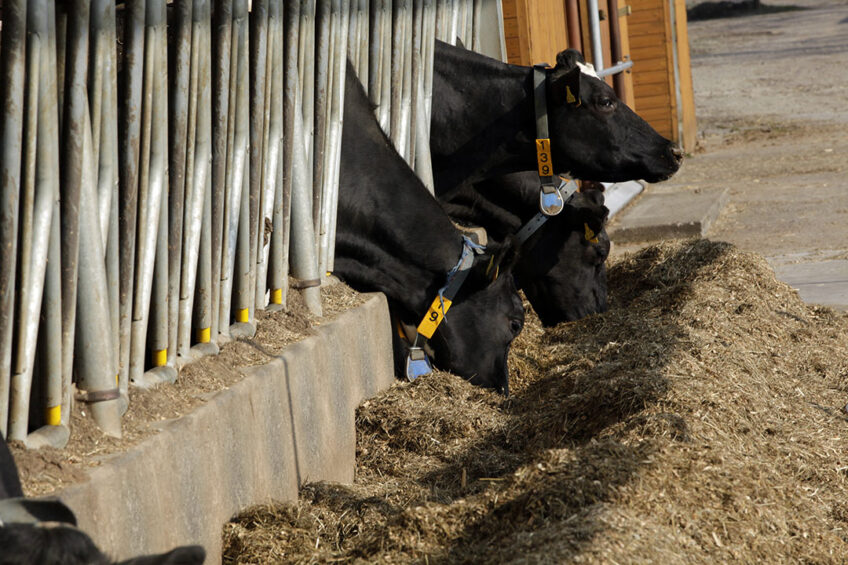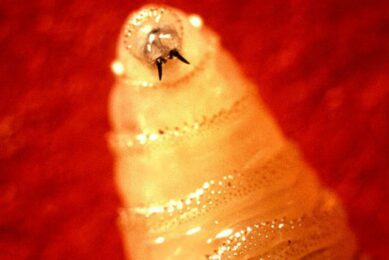Avoiding milk fat drop during heat stress

Heat stressed dairy cows often suffer milk fat depression, which can be costly to producers in the current challenging dairy market. However, ongoing research suggests that optimising rumen function can help sustain milk fat concentrations in cows under heat stress.
Milk fat synthesis depends on fatty acids from 2 sources:
- Long-chain fatty acids (greater than 16 carbon atoms per molecule) – derive from the uptake of circulating preformed fatty acids, dietary fat absorbed from the digestive tract, and non-esterified fatty acids (NEFA) from the mobilisation of body fat reserves.
- Short-chain (4 to 8 carbons) and medium-chain (10 to 14 carbons) fatty acids – originate in the mammary gland from de novo synthesis (fatty acids created ‘anew’ in the mammary from smaller molecules).
The 16-carbon fatty acids can originate from both sources. For a well-fed cow, an estimated 4% to 8% of milk fatty acids originate from the breakdown of body fat (such as NEFA). However, the proportion of fatty acids from this source could increase progressively as the cow’s net energy balance decreases (Bauman and Griinari, 2001). Under heat stress, there are two potential mechanisms for milk fat depression (MFD). The first one is rumen fatty acid biohydrogenation – inhibiting de novo milk fat synthesis. The second one is rumen lipopolysaccharide – limiting substrate supply and de novo milk fat synthesis.

Altered fatty acid biohydrogenation
According to the well-accepted ‘biohydrogenation theory’ (Bauman and Griinari, 2001), MFD results from changes in rumen biohydrogenation of unsaturated fatty acids and the passage of specific intermediates of biohydrogenation out of the rumen (such as trans-10, cis-12 CLA). These biohydrogenation intermediates subsequently interfere with the expression of genes involved in fat synthesis thereby reducing milk fat synthesis in the mammary gland. Furthermore, the increased rate of feedstuffs outflow from the rumen may increase the likelihood of biohydrogenation intermediates passing through the rumen. So the theory identifies how certain feedstuffs can represent risk factors for MFD (Figure 1). Dairy nutritionists sometimes suggest feeding supplemental fat to maintain the cow’s energy intake during heat stress. However, it is important that the source of fat is rumen inert. Otherwise, low rumen pH, which occurs in heat stressed cows, could generate more intermediates of biohydrogenation and increase the risk of MFD.
Figure 1 – Dietary components can impact the risk of milk fat depression in 3 ways through the rumen biohydrogenation (BH) pathway.
Altered rumen LPS production
The other potential mechanism for MFD during heat stress involves the concentration of rumen lipopolysaccharide (LPS), which comes from Gram-negative bacteria when they die. Research shows that when rumen pH decreases, the rumen concentration of LPS increases. Also, as rumen LPS concentration increases, milk fat concentration decreases. Zebeli and Ametaj (2009) showed greater concentrations of rumen LPS as the proportion of grain in the diet increased. As rumen LPS increased, milk fat content decreased (Figure 2). This correlation could be due to the ability of LPS to induce insulin production in the pancreas (Waldron et al., 2006). Increased circulating insulin and increased insulin sensitivity of heat stressed cows could reduce body fat mobilisation. This condition could occur even though heat stressed cows are under negative energy balance due to reduced feed intake and increased maintenance demands (Baumgard and Rhoads, 2013). Also, the lack of plasma NEFA, potentially an important precursor for milk fat synthesis under heat stress (Bauman and Griinari, 2001), may contribute to MFD. Other reported negative LPS effects on fatty acid production include: Decrease in activity of lipoprotein lipase (Lopez-Soriano and Williamson, 1994), decrease in expression of lipoprotein lipase and fatty acid transport protein 1 (Feingold et al., 2009) and suppression of enzymes related to de novo fatty acid synthesis in the mammary tissue (Dong et al., 2011).
Figure 2 – Correlation between rumen lipopolysaccharide (LPS) and milk fat content.
Optimising rumen function during heat stress
Research to date helps explain how MFD during heat stress relates to depressed rumen health. Given this relationship, optimising rumen function could help maintain milk fat content and production efficiency of dairy cows under heat stress. Heat stress causes physiological and behavioural changes in dairy cows. These changes can lead to suboptimal rumen conditions, resulting in production of fatty acid biohydrogenation intermediates and LPS that inhibit milk fat synthesis in the mammary gland. Today, natural digestive health technologies are available to help optimise rumen conditions through the diet, thereby helping to reduce the negative impact of heat stress on milk fat and maintain the production efficiency of high-producing dairy cows.
References are available on request.
Join 13,000+ subscribers
Subscribe to our newsletter to stay updated about all the need-to-know content in the dairy sector, two times a week.












